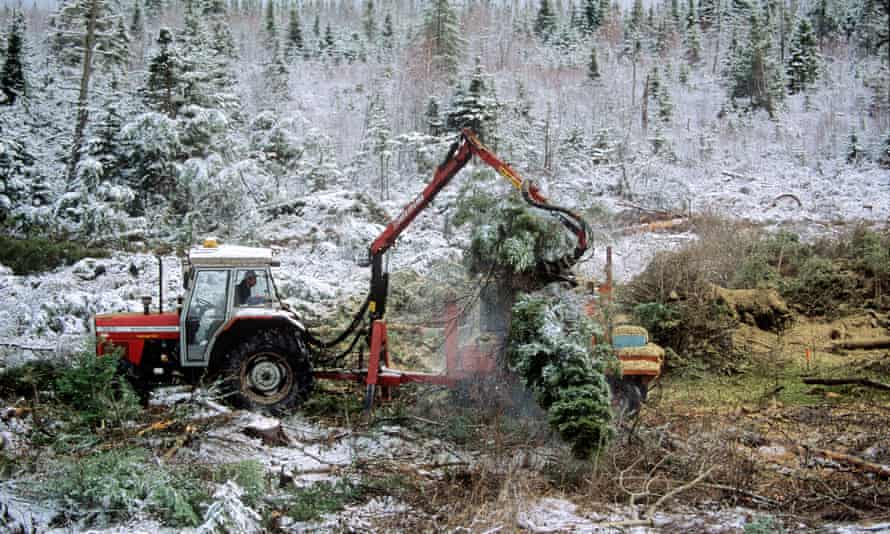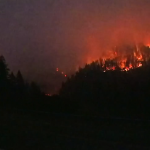A man in the second week of a hunger strike is calling on the Canadian government to halt logging, amid growing fears that clearcutting the country’s eastern forests could prove devastating for endangered species.
Jacob Fillmore, a 25-year-old activist in the province of Nova Scotia, has survived on broth and water for 12 days, camping outside the province’s legislative assembly to raise awareness over the destruction of old-growth forest.
“I recognise that a hunger strike is quite an extreme measure to take to get my message heard, but I think it’s time for extreme measures,” Fillmore told the Guardian. “We really don’t have any time to lose.”
Early in the week, protesters joined Fillmore in Halifax, the province’s capital, blocking roads and demanding the government halt the controversial logging practice of clearcutting, which they fear is pushing ecosystems to the brink. Support for Fillmore’s protest also speaks to a broader frustration across Canada over the continued harvest of old-growth forests – despite warnings from ecologists that the ageing trees represent a valuable tool in the fight against climate change.

For more than three centuries Nova Scotia’s forests have been harvested for valuable timber exports. But generations of relentless extraction have left the province with few remaining stands of Acadian old-growth, a mix of hardwood and softwood trees that once blanketed much of the Maritime province.
“Our forests used to be enormous,” said Bob Bancroft, a wildlife biologist and head of Nature Nova Scotia, a collection of environmental advocacy groups. “I’ve seen elm trees where four of us could barely get our arms around to touch fingers. And I’ve seen yellow birch that measured over 13ft in circumference. But there’s hardly any of that left now.”
Bancroft estimates that half of the province’s forests have been logged over the last 35 years. For residents, the rapid disappearance of the mainland moose – whose numbers have collapsed in recent years – has become emblematic of the unfolding ecological disaster.
With its shelter and food sources disappearing, the endangered moose population is increasingly being pushed to fewer and fewer forested areas.
“It’s a bit like somebody knocking on your door and saying, ‘Excuse me, I’ve lost my home, I want to live in your house,’” said Bancroft. “They’re being pushed back to the last bastions of wildness that they can find because there’s nowhere else to go.”
WestFor, the main harvester in the region, did not respond to the Guardian’s request for comment. The company recently released a video defending its logging practices, telling a report that it believes “a responsible forest industry can be balanced with the need to protect our natural environment, including endangered species such as the mainland moose”.
The Nova Scotia government also did not respond to a request for comment.
In addition to habitat degradation, a recent push by the Nova Scotia government to use harvested wood for electricity generation has prompted concern among campaigners.
“We can’t consider our forests as a resource to be burned,” said Gretchen Fitzgerald, a national programme director at the Sierra Club of Canada. “And we know that old-growth forests are especially critical for drawing down carbon to confront the climate emergency.”

Activists are growing increasingly frustrated with what they see as a lack of meaningful action, despite promises from successive provincial governments to reform forestry management practices.
In 2019 a provincial court found that the government had failed to meaningfully protect the moose under its endangered species laws.
In October 2020 members of Extinction Rebellion set up two blockades on logging roads in south-western Nova Scotia, where one of the few stands of old-growth forest remains.
“Forests of mature evergreens are exactly the kind of habitat that the moose needed – and it’s exactly the kind of habitat that the forestry industry wants to get its hands on,” said Nina Newington, one of the activists who spent eight weeks at the blockade site.
In December, police arrested nine of the protesters, including Newington, as they enforced a court injunction in favour of WestFor.
And it was in December that Fillmore began camping out in front of government buildings, refusing to leave until the government implements a moratorium on logging in ecologically sensitive areas.
His refusal to eat until the government agrees to a temporary ban, an escalation of his previous protests, has raised concern from fellow protesters.
“It scares and saddens me that a 25-year-old guy is doing this to his body,” said Newington. “But I also admire him enormously for it.”
The newly appointed premier, Iain Rankin, has pledged to implement recommendations from the recent forestry report, as well as prioritising action on climate change – a move welcomed by activists.
But Rankin, who previously ran the government’s department of lands and forests, has warned that any changes will probably come at the end of the year. The premier’s office did not respond to a request for comment on Fillmore’s calls for a moratorium.
Fillmore, who has grown increasingly lethargic without food, says his fight reflects his desperation over the loss of forests.
“Without substantial action on climate change, food security is going to be a real issue for people, as it already is for many species on the planet,” he said. “My sense of urgency comes from a fact to that I’m scared for my future.”

Average Rating